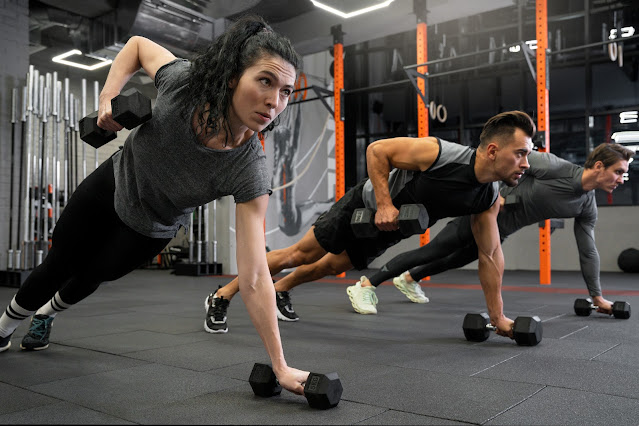10 Benefits of Strength Training and How to Do It Safely
Weight Lifting Should Be Part of Your Fitness Routine
Weight lifting, also known as strength training or resistance training, is a huge part of losing weight and looking good. There are so many benefits to weight training. You will look healthier. You’ll be stronger. You will feel better. And LADIES! – contrary to popular belief, lifting weights won’t necessarily make you look bulky or like a man! I hate to break it to you… but strictly limiting yourself to long hours on the cardio machines will not give you the body you want.
Yes, cardio will help you lose weight — but it will be a combination of losing fat and losing muscle. Lifting weights is not just for people who want to bulk up and gain muscle mass. For most women (myself included), we want lean muscle, and one way to get that is to lift weights.
Reasons to Lift Weights and Strength Train
1. You will burn more calories.
Yes, you read that right! Lifting weights, especially doing combo movements or utilizing your bigger muscle groups, will burn more calories than doing cardio for the same amount of time. An additional benefit of lifting weights is that you’ll burn more calories after leaving the gym too! After a good weight-lifting session at the gym, your body will need the energy to repair your muscles. Therefore, your body is burning more calories than it would be if you hadn’t lifted those weights!
2. You’ll burn more fat.
I mentioned it briefly above. Cardio will help you lose weight… by burning fat AND muscle. So when you look in the mirror, you most likely won’t be entirely happy or satisfied with what you see. Weight lifting helps preserve the muscle that you do have, as well as build upon and tone it… Leaving fat to be burned. YES!
3. You will feel happier.
There are more than just physical benefits that come with weightlifting. You’ll also reap the rewards mentally and emotionally. Weightlifting is a known stress reliever. Also, your heart will be able to handle stress better!
4. You’ll look more toned and defined.
That image you’ll see in the mirror will be more similar to the bodies of those that you see in magazines, on Instagram, etc. As women, we have lower testosterone levels… So we don’t have to be scared of looking like the hulk when we lift heavy!
5. You will help keep yourself away from injury.
Strengthening the muscles surrounding our joints is one of the BEST ways to prevent injuries. Nobody likes an achy shoulder, knee, back, etc.
It is very important to prevent injury. One of the best ways to make sure that you don’t hurt yourself while weightlifting is to use the correct weight while exercising.
How to Choose the Right Weight
- 1. There is not a perfect, correct answer to the question “How much weight should I lift?” because there are so many variables that go into it. For example, what are your goals? The answer varies if you want to build endurance, muscle mass, etc.
- 2. Start with just your body weight to get your form right! If you are new to weight lifting, then practice the exercises without weights to get accustomed to it.
- 3. For bar and barbell use: Start with a weight that challenges you but does not hurt you. For example, you should be able to feel your muscles working (burning) but still able to perform controlled movements even on your last rep. You can add weight if it feels too light for your next set. I always recommend starting light and increasing the weight if you find that it is too easy for you.
- 4. For dumbbell use: Find the heaviest weight you can do one rep of your exercise with correctly. Take 65% of that and there you go. Try picking up a dumbbell to feel its weight in your hand and perform one rep of the exercise. Find the heaviest dumbbell you can lift and do just one rep of your exercise with. For example, if you can perform one bicep curl with a 20-pound dumbbell easily, but can’t even bend your elbow when you try a 25-pound dumbbell… then 20 pounds is the number you will take 65% of! 65% of 20 is (20 x .65) 13 pounds!
- 5. I make customized workout plans if you’d like a personalized workout routine from a personal trainer instead of using these generic guidelines!
Here’s the key to the most efficient and effective weight loss: Weight lifting AND Cardio! BOTH! I love cardio. I started my fitness journey by running. It was my self-care. I loved (and still do love!) it so much… But I wasn’t seeing the results I wanted with the amount of work and effort I was putting in. Weight-lifting changed that… and I know it will for you too.
Frequently Asked Questions About Weight Lifting
1. What is weight lifting?
Weight lifting is the act of lifting weights (barbells, dumbbells, etc.) as a sport or for non-competitive exercise.
2. What is strength training?
Many times you will see weight lifting, strength training, and resistance training used interchangeably… but there are some differences! Weight lifting and resistance training are both types of strength training.
Strength training is the act of using resistance to build and increase strength. Resistance can be in the form of weights, resistance bands, or bodyweight exercises! Whatever exercise you are doing, you can add resistance to make the movement harder…which will, in turn, make you stronger and increase your muscle strength!
3. Is lifting weights good for you?
In the vast majority of cases, YES! There are so many benefits of lifting weights (see below for a more detailed explanation!).
It is always best to consult your medical doctor before starting a weightlifting routine. There may be some instances when you might need to ease into it slowly or abstain from lifting weights.
4. Does weightlifting burn fat?
Yes, yes, thousand times yes! I provide a very in-depth explanation below.






